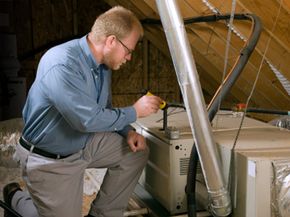Heating systems are usually trouble-free and easy to maintain. Efficient operation is a function of good regular maintenance. No matter what type of furnace you have, there are several things you can do to keep your heating system in top condition. In this article, we will tell you how to service and troubleshoot your furnace, regardless of the type.
When a heating or cooling system malfunctions, any one of its three components -- heat/cold source, distribution system, or thermostat -- may be causing the problem. If the furnace or air conditioner doesn't run, the malfunction is probably at the source. The furnace or air conditioner may have lost power. Fuel may not be reaching the unit. If the fuel is gas or oil, it may not be igniting. If the furnace or air conditioner turns on but the warm or cool air isn't reaching the rooms of your home, the problem is likely to be the blower or distribution system. And a faulty control, or thermostat, could keep the system from turning on or could cause it to turn on and off repeatedly. Whatever the problem, start with the simplest procedures. In most cases, all it takes is patience and common sense.
Advertisement
Before you start work on a heating or cooling system, take these preliminary steps:
- Make sure the unit is receiving power. Look for blown fuses or tripped circuit breakers at the main entrance panel. Some furnaces have a separate power entrance, usually located at a different panel near the main entrance panel. Some furnaces have fuses mounted in or on the unit.
- If the unit has a reset button, marked RESET and near the motor housing, wait 30 minutes to let the motor cool, then press the button. If the unit still doesn't start, wait 30 minutes and press the reset button again. Repeat at least once more.
- If the unit has a separate power switch, make sure the switch is turned on.
- Check to make sure the thermostat is properly set. If necessary, raise (or, for an air conditioner, lower) the setting 5º.
- If the unit uses gas, check to make sure the gas supply is turned on and the pilot light is lit. If it uses oil, check to make sure there is an adequate supply of oil.
There are also several important safety factors to remember:
- Before doing any work on any type of heating or cooling system, make sure all power to the system is turned off. At the main electrical entrance panel, trip the circuit breaker or remove the fuse that controls the power to the unit. If you're not sure which circuit the system is on, remove the main fuse or trip the main circuit breaker to cut off all power to the house. Some furnaces have a separate power entrance, usually at a different panel near the main entrance panel. If a separate panel is present, remove the fuse or trip the breaker there.
- If the fuse blows or the circuit trips repeatedly when the furnace or air conditioner turns on, there is a problem in the electrical system. In this case, do not try to fix the furnace. Call a professional service person.
- If the unit uses gas and there is a smell of gas in your home, do not try to shut off the gas or turn any lights on or off. Get out of the house, leaving the door open, and immediately call the gas company or the fire department to report a leak. Do not reenter your home.
- To keep your heating and cooling systems in top shape, have them professionally serviced once a year. The best time to have a furnace serviced is at the end of the heating season. Because this is the off-season, you can often get a discount, and service is likely to be prompt. Have your air conditioner checked at the same time.
The heat/cold source is the most complicated part of the heating and cooling system, and it's the part most likely to suffer from neglect. Problems in this area may also lead to distribution problems. Whatever heat/cold source your system uses, give it regular attention to prevent problems.
Dirt is the biggest enemy of your home's heating and cooling system. It can waste fuel and drastically lower efficiency. Dirt affects all three basic components of the system, so cleaning is the most important part of regular maintenance. Lubrication and belt adjustment at the furnace are also important.
To keep your system working properly, there are some simple general procedures you can follow. To start, learn how to clean your furnace. We'll show you how on the next page.
For more articles on home repair, check out the following links.
- How To Repair Gas Furnaces and Gas Heaters: Gas furnaces have become popular because they burn fuel cheaply and with few problems. Keep your gas furnace running trouble-free.
- Major Appliance Repair: If the furnace isn't the only thing in your house on the fritz, you can learn how to fix other machines in this article.
- Small Appliance Repair: Once you've tackled the furnace, a toaster or blender seems like child's play. Find out how to fix them here.
- Thermostat Maintenance: To make sure there's actually a problem with your heating system, you may want to check the thermostat, too. Learn how to calibrate a thermostat.
